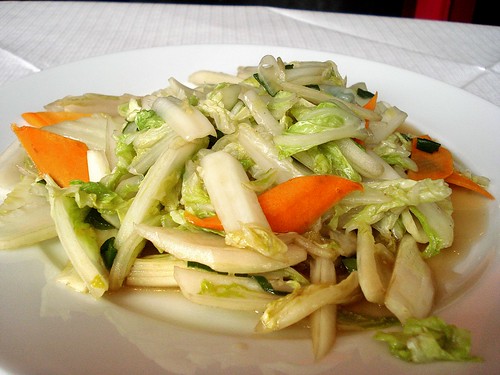Today's dim sum item is a little more substantial than the ones I've posted about previously: 糯米雞 (nuò mǐ jī). This literally means "chicken with glutinous rice" — 糯米 is glutinous rice, and 雞 is chicken. Usually left implicit in the name is the fact that this chicken/rice mixture is wrapped up in a lotus leaf before being steamed, though you may sometimes see the lotus leaf explicitly mentioned, as 荷葉糯米雞 (hé yè nuò mǐ jī). 荷 means "lotus", and 葉 means "leaf" [see footnote].
The most common Cantonese transliteration I've seen for this is "lo mai gai", while English translations include "steamed mini glutinous rice wrapped in lotus leaf", "glutinous rice with meat in lotus leaves", "mini glutinous rice in lotus leaves", and other variations on the same theme. As well as the chicken and rice, the ingredients include Chinese sausage (臘腸/là cháng) and Chinese mushrooms; these savoury items are seasoned with soy sauce, ginger, etc, and then buried in the centre of the rice parcel, to be revealed when you open it up and dig in (illustrated below).
The glutinous rice used in this dish is not the same as the rice used to make, for example, fried rice or plain steamed/boiled rice. It's also known as "sticky rice", and is a different variety from jasmine and other long-grained rices. As well as its culinary uses, it's also been used historically to make masonry mortar for walls and buildings.
As mentioned above, 糯米雞 can be quite filling, so you may not want to eat an entire parcel on your own, at least if you want to try lots of the other dim sum dishes! Though this does depend on the size of the parcel — some places just give you one big one, others give you two or even three smaller ones.
If you'd like to try making this at home, check out Sunflower's 糯米雞 recipe. I like it with the chicken on the bone, but you can always use boneless chicken if you find the bones too fiddly.
Footnote: [0] Regular readers may recognise 荷/hé/lotus from my post on 豆/dòu/bean, since it appears in one of the names for mangetout — 荷蘭豆 (Hélán dòu, literally "Dutch bean", as 荷蘭 is a phonetic representation of "Holland"). Similarly, 葉/yè/leaf has also appeared here before, as 牛柏葉 (niú bǎi yè), or leaf tripe.






















